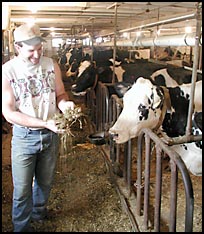A day in the life of a dairy farm
The idea behind the WCCO broadcast is to expose the public to a day in the life of a farm. On the Burg farm, chores - milking, feeding, and cleaning the barn - start at 6 a.m. It takes Duane and Dan Burg about 90 minutes to milk the 80 cows in their tie-stall barn. Calf feeding takes another 45 minutes.
Calving is an important part of every dairy operation. The female calves are raised for two years before they produce milk, and the male calves are raised for 15 months or so for beef. Tending for the young of the herd insures the replacement of animals.
But the cows only give milk after calving. Once a cow has freshened (as calving is known on the farm) she will milk for about 300 days, or ten months before going dry. She will only start milking again a couple months later, after giving birth to another calf.
Milking is done twice a day on the Burg farm, starting again at 5 p.m. "If you keep a routine, you keep a healthier animal and get better production from your cows," explained Duane of milking on a set schedule.
The afternoon chores tend to go faster because Duane and Dan frequently are helped by other members of the family: Irene, who works in a bank in St. Martin during the day, Duane and Irene's youngest child, Nathan, an eighth grader who is the youungest of the Burgs' six children, or Lynn.
"This is as family as you're going to get," said Duane.
Midday
After the morning chores are done, the Burgs have time to tackle other tasks. In the spring, that's planting 250 acres of corn and 50 acres of nursing crop, which is used to rotate the 100 acres of alfalfa on the farm.
Periodically throughout the summer, they cut their alfalfa and harvest the crop. While they rely on corn for much of the energy in the diets of their animals, alfalfa provides the protein. It's an important harvest," said Duane. "It's an important part of dairying. You get a lot of value from an acre of alfalfa ground."
"Keep your quality as good as you can. That way the less commercial protein you have to buy," he added.
In the summer and winter, the midday can be used as down time, but in the fall, they are busy harvesting their crops between chores. "Everything we raise on this farm we feed to the animals: the cows, the calves, and the steers," said Duane.
They store corn silage, haylage, and moist corn in silos, and the rest in bunkers.
Economics of farming
 Each milk cow on the Burg farm eats roughly the same amount of food each day as the milk it produces.
Each milk cow on the Burg farm eats roughly the same amount of food each day as the milk it produces.
For the entire 80-cow dairy herd, the Burgs average about 72 pounds of milk per cow per day, just what it averages in feed. Their leading cow produces 130 pounds of milk a day, and eats 150 pounds of food and drinks several gallons of water to do so. "This cow I can hardly keep food in front of," said Dan.
The milk is tested every month to insure proper nutrition and check what proportion of foods needs to be in the cow's diet. The feed is mixed using a total mixed ration machine.
Dan Burg holds rations for the cows. The feed is mixed for optimum nutrition to maximize milk production.
The 400 animals on the farm turn the products of the earth - mainly corn and alfalfa - and turns them into commodities. Cows turn their feed into milk, and the steers into beef. "You can take your products from the field and double your money by running it through a cow for milk or beef rather than to sell (the crops) for cash," said Duane.
"That's why if you're strictly into cash cropping you need to have a lot of acres," he added.
Back when Duane grew up on a dairy farm north of St. Martin, farms weren't as specialized. "They were more diversified in those days. Everybody had some cows, chickens, and hogs," said Duane. "Whatever. Now it's strictly one, or at the most two. In our case, it's dairy and beef."
In the past year, the low prices of dairy would have exerted lots of financial pressure on the farm, except that the beef market was relatively strong. "The soup would have been pretty thin except for the beef," said Duane.
Recently, supply of dairy products has dropped, improving the market. Duane feels the answer for the farm crisis isn't to increase production, but to get better prices for the products. "If everybody keeps milking more cows, that's not the answer," he sad.
"The more efficient we got, the less we got for our product," said Duane.
Now, though, dairy prices are climbing back to $15 per hundredweight, good news for the dairy industry after more than a year of prices around $10.
"Every business in Paynesville will benefit from it. Every business in St.Martin will benefit from it," said Duane of the resurgence in farm prices.
Food - and the wealth it creates - comes from the ground, a lesson the Burg family hopes to share on Friday.
Contact the author at paypress@lkdllink.net • Return to News Menu
Home | Marketplace | Community